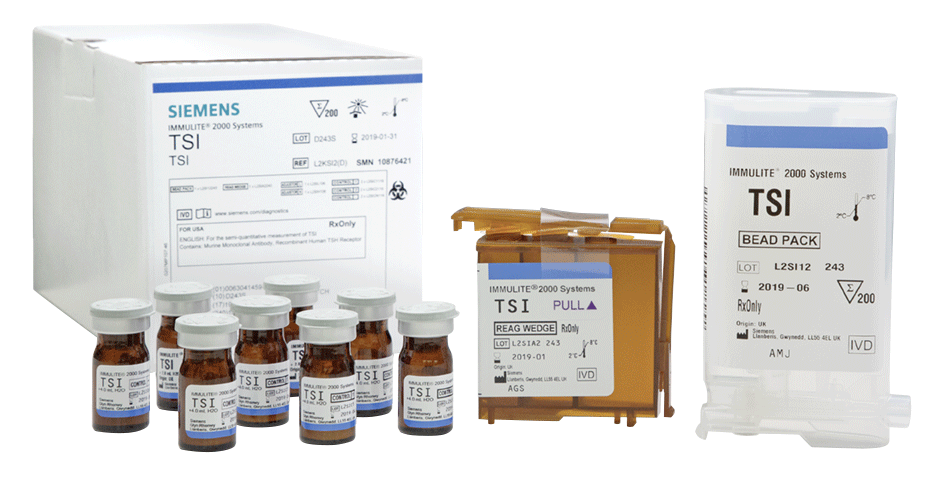Graves’ disease (GD) is an autoimmune disorder caused by the presence of thyroid stimulating immunoglobulins (TSI) that bind to the TSH receptor on the thyroid cells and stimulate the uncontrolled production of thyroid hormones. Detecting the presence of TSI in the blood is a powerful diagnostic tool for the differential diagnosis of GD.
TSI measurements are also used to monitor the response to GD therapy and prediction of remission or relapse, confirm Graves’ ophthalmopathy, and predict neonatal thyroid hyperthyroidism.1,2
The IMMULITE® 2000 and 2000 XPi TSI assay is the first automated, quantitative TSI assay available. TSH receptor antibody (TRAb) assays detect both thyroid-blocking and -stimulating antibodies. However, blocking antibodies inhibit TSH stimulation of thyroid cells and lead to hypothyroidism.
The IMMULITE 2000 and 2000 XPi TSI assay detects thyroid stimulating antibodies, the specific cause of GD pathology, with a clinical sensitivity and specificity of 98.3% and 99.7% respectively. With a 65-minute total assay time and ready-to-use, stable reagents, the use of this assay can make the differential diagnosis of GD faster and easier, allowing patients to be diagnosed and treated sooner.
Understanding Graves’ disease
Graves’ disease is an autoimmune disorder that leads to hyperthyroidism or the overactivity of the thyroid gland. It is caused by an abnormal immune system response that causes the thyroid gland to produce too much thyroid hormone.
The thyroid gland is a butterfly-shaped organ that lies flat against the windpipe in the throat. It produces the hormones thyroxine (T4) and triiodothyronine (T3) and plays an important role in controlling the body's metabolism.3
What are the symptoms of Graves’ disease?
Those who have Graves’ disease may exhibit typical signs of hyperthyroidism, including:
- Nervousness or irritability
- Fatigue or muscle weakness
- Heat intolerance
- Trouble sleeping
- Hand tremors
- Rapid and irregular heartbeat
- Frequent bowel movements or diarrhea
- Weight loss
- Goiter, an enlarged thyroid that can make the neck appear bloated and impair regular breathing and swallowing.
Individuals with Graves’ disease may have the appearance of larger eyes because their eyelids are retracted or seem to be pulled back into their sockets, and their eyeballs protrude from their sockets. This condition is called Graves’ ophthalmopathy.4
Who is likely to develop Graves’ disease?
Women are more likely than men to develop Graves’ disease, which often affects adults under 30.4
There is a good chance that age, sex, heredity, emotional stress, and environmental stress are implicated with Graves’ disease. Also, if a person has Hashimoto’s or Graves’ disease in their family, their risk of acquiring it rises. The disorders most likely result from a combination of genes and an external stimulus, such as a virus.4
Laboratory testing
For Graves’ disease patients, laboratory testing is crucial to confirm the diagnosis, determine the severity of the disease, monitor the condition, and help plan treatment. Testing for detecting thyroid dysfunction might start with:
- TSH: typically low in Graves’ disease
- Total T4 or free T4: usually elevated
- Total T3 or free T3: often elevated
To track thyroid function and hormone synthesis, the tests mentioned above may be requested periodically.
Laboratory tests used to help diagnose Graves’ disease and distinguish it from other autoimmune conditions may include one or more tests used to detect the presence of thyroid antibodies:3
- Thyroid stimulating immunoglobulin (TSI): The presence of this antibody is diagnostic for Graves’ disease.
- Thyroid stimulating hormone receptor antibody (TRAb): Less specific than TSI.
- Anti-thyroid peroxidase antibody (anti-TPO): This autoantibody is found in most people with Graves’ disease, as well as in Hashimoto thyroiditis.
Assay specifications
IMMULITE 2000 and 2000 XPi TSI Assay
Source: Siemens Healthineers
| . |
. |
| Sample Type |
Serum, plasma (Li heparin, EDTA) |
| Sample Volume |
50 µL |
| Assay Range |
0.10–40 IU/L |
| Limit of Quantitation |
0.10 IU/L |
| Calibration Interval |
4 weeks |
| Onboard Stability |
90 days |
| Time to First Result |
65 minutes |
| Clinical Sensitivity |
98.3% |
| Clinical Specificity |
99.7% |

- Gupta, Manjula K. Thyrotropin-receptor antibodies in thyroid diseases: advances in detection techniques and clinical applications. Clinica Chimica Acta. 2000;293:1-29
- Bjorgaas MR, Farstad H, Christiansen SC, Blaas H-GK. Impact of thyrotrophin receptor antibody levels on fetal development in two successive pregnancies in a woman with Graves' disease. Horm Res Paediatr. 2013;79(1):39-43.M.R.
- http://labtestsonline.org/understanding/conditions/graves/
- https://www.niddk.nih.gov/health-information/endocrine-diseases/graves-disease
The products/features (mentioned herein) are not commercially available in all countries. Due to regulatory reasons their future availability cannot be guaranteed. Please contact your local Siemens representative for additional information.